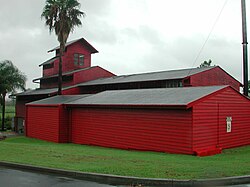Beenleigh Rum Distillery
| Beenleigh Rum Distillery | |
|---|---|

Beenleigh Rum Distillery
|
|
| Location | Distillery Road, Eagleby, City of Logan, Queensland, Australia |
| Coordinates | 27°43′26″S 153°13′21″E / 27.7238°S 153.2224°ECoordinates: 27°43′26″S 153°13′21″E / 27.7238°S 153.2224°E |
| Design period | 1870s - 1890s (late 19th century) |
| Built | c. 1890 - c. 1980 |
| Official name: Beenleigh Rum Distillery | |
| Type | state heritage (built) |
| Designated | 6 March 2004 |
| Reference no. | 602470 |
| Significant period |
c. 1890 (fabric) 1884-1969, 1972-c. 2003 (historical) |
| Significant components | factory building, still house, store/s / storeroom / storehouse |
Beenleigh Rum Distillery is a heritage-listed rum distillery at Distillery Road, Eagleby (once part of Beenleigh), City of Logan, Queensland, Australia. The distillery produces Beenleigh Rum. It was built from c. 1890 to c. 1980. It was added to the Queensland Heritage Register on 6 March 2004.
The Beenleigh Rum Distillery on the banks of the Albert River was licensed in 1884 and utilised molasses from sugar grown and crushed in the area. The town of Beenleigh developed consequent to the growth of sugar related industries in the area and took its name from the plantation that the preceded the establishment of the distillery.
Moreton Bay penal colony commandant Captain Patrick Logan explored the area around the Logan and Albert Rivers in 1826. Timbergetters in search of cedar and hardwoods moved into the district around 1840, but the first European settlers took up land in 1864 under the Sugar and Coffee regulations, a government scheme to encourage the growing of these potentially valuable crops in the new colony of Queensland. Leases of between 320 and 1280 acres were available for three years with an option to purchase, in order to encourage the establishment of plantations. 39 leases were granted in the first months of the scheme's operation of which 10 were in the Logan area, and at all of which it was intended to grow sugar.
Sugar cane had been first brought to Australia in 1788 but subsequent plantings at Sydney, Port Macquarie and Norfolk Island failed to be commercially viable. Captain Louis Hope grew a cane crop successfully in Ormiston in Queensland in 1862. By 1864 the first commercial sugar mill in Australia had been established by him at Ormiston and interest in growing sugar cane spread rapidly. By 1867 an estimated 2000 acres were under cane in the Brisbane area and by the end of the decade, cane had also been successfully established further north at Maryborough, Mackay and Bundaberg, where the warmer climate proved more suitable, and sugar was established as a major commercial crop in Queensland.
...
Wikipedia

